Instagram Posts for Andean Lab Receive International Thumbs-up

Taking advantage of the many visual highlights of archaeology, students from the Andean Laboratory at the Cotsen Institute have established a social platform on Instagram. By posting photos and conversational captions, Louise Deglin and Alba Menéndez Pereda have already acquired more than 1300 international followers in their efforts to increase awareness of Andean art and archaeology.
Deglin, who is a PhD candidate in art history, says that she likes “communication through images.” She explained that the images from the Andes are powerful and engaging. 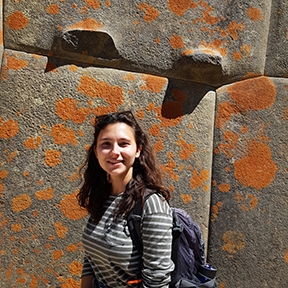 Menéndez Pereda, a PhD candidate in archaeology at the Cotsen Institute, emphasized the use of images and videos and that “text is almost secondary. You first have to grab people’s attention through pictures and then get them to open and read the caption that goes with the picture. We use Instagram for outreach purposes and the communication of science,” she explained, quite unlike most well-known usage for marketing by companies and influencers on the platform.
Menéndez Pereda, a PhD candidate in archaeology at the Cotsen Institute, emphasized the use of images and videos and that “text is almost secondary. You first have to grab people’s attention through pictures and then get them to open and read the caption that goes with the picture. We use Instagram for outreach purposes and the communication of science,” she explained, quite unlike most well-known usage for marketing by companies and influencers on the platform.
“I also like the fact that Instagram reaches a younger audience,” Deglin added. “We are talking about a broad audience, especially as the captions are in both English and Spanish.” Their followers include, among many others, first and second-generation Andeans in the United States who are trying to get back in touch with their own culture, she explained. “I feel that we should be paying more attention to all indigenous people in the United States, not just the native populations from North America. And I want to show that everyone is interested in that broader-based cultural heritage.”
With her facility for languages, Deglin has been able to communicate with some followers in Quechua, the indigenous language still spoken by millions throughout Ecuador, Peru and Bolivia. Both she and Menéndez Pereda took a one-year course at UCLA in its Ecuadorian dialect. Although there is no class for Peruvian Quechua, Deglin pointed out that a number of Instagram pages are devoted to people teaching Quechua. She follows them, along with others who have expressed interest in the Instagram account of the Andean Laboratory.
Followers are those people who have viewed the Instagram page and are interested in being notified when new items are posted. Deglin and Menéndez Pereda add new content every week to keep people involved. Deglin had experience with social media through her cultural blog, which she ran for four years when she lived in Paris. “I very much enjoyed sharing through social media, and it is one of the best ways to offer accessible and free content for everyone. The Andean Lab Instagram page also gives us an opportunity to really identify with UCLA. We have an opportunity here to focus on the members of the laboratory, our activities, and our own research,” she said.
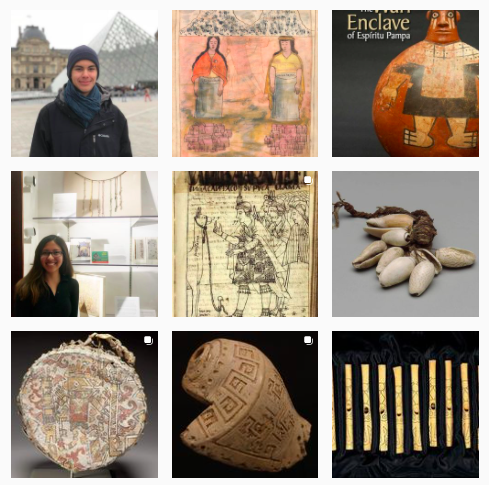 Deglin has been surprised at the number of people who have expressed an interest in the account. “It started when some academics started following us. For instance, I was especially happy when the curator of Andean art from the Metropolitan Museum of Art in New York followed us. But then it began to grow, and I became very excited about the number of Peruvian followers we have, many of whom have expressed that as people of Andean descent, they are very pleased to feel represented,” she added.
Deglin has been surprised at the number of people who have expressed an interest in the account. “It started when some academics started following us. For instance, I was especially happy when the curator of Andean art from the Metropolitan Museum of Art in New York followed us. But then it began to grow, and I became very excited about the number of Peruvian followers we have, many of whom have expressed that as people of Andean descent, they are very pleased to feel represented,” she added.
People find the Instagram page of the Andean Laboratory when they search Instagram for different topics which they are interested. Viewers search by hashtags such as #Andeanart or #archaeology. Deglin pointed out that the more general the hashtag, the less likely you are to be noticed. So she and Menéndez Pereda have tried to be more specific with their hashtags, using terms such as #indigenousart or even #abyayala, which is the indigenous name for the Americas. “We also put hashtags in different languages, especially English and Spanish, because we have a lot of followers who speak Spanish,” she added.
Deglin explained that she and Menéndez Pereda have a planner prepared ahead of time. She emphasized that a good way to be positioned at the top of the suggested posts under a specific hashtag is to publish regularly, always at the same time, and always on the same day. “Of course that is tricky if you are in the middle of something, and you have to stop to take care of your Instagram post,” she added. Menéndez Pereda noted that if you do not post frequently, your account gets pushed to the bottom of the suggestions list that pops up when someone searches for a topic.
“I also try to follow a lot of people who follow us and comment on their posts,” Deglin said. “When I want to share, I just have to look at the people I follow and use that community. Now that the Andean Laboratory community has grown, sharing is much easier. Traditionally, if someone follows you, you would check out their Instagram account and probably follow them, too,” according to Deglin.
Menéndez Pereda explained that they tag other institutions or individuals “ if we feature their research in our posts. If they are on Instagram, they can then share it themselves on their accounts. This will help drive more people to our site. You can initiate following people early in the stages of your Instagram account, but you want to be sure you have some content for them to view if they follow you back,” she continued.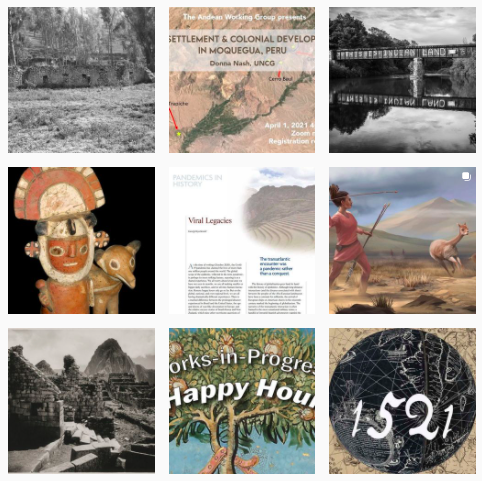
“We publish our own content, for example, a poster I had made for the last talk we organized,” Deglin explained. “If we use previously published images, we always give credit for where they came from.” Menéndez Pereda added that they put up information about upcoming events and lectures, as well as “beautiful pictures of Andean landscapes and Andean ceramics that grab a lot of attention. Louise and I work together and are in constant communication. Recently, we each had a series of posts about topics we are individually interested in. Louise created a series on Wari ceramics, and I did one on Andean music.” She added that they dedicate 20-30 minutes each day to look at the account to see if there are any messages and to evaluate how the posts are doing.
“The goal is to stay accessible,” Deglin emphasized. “Because we are academics, we tend to use complex vocabulary. We want to show everything we know as it has taken a painstakingly long time to learn. But I think we have to remember what it is to just talk to people and make them feel welcome to the discussion. With social media, the conversation has to be accessible, and it has to be enticing. So images are everything.”
Menéndez Pereda added that they frequently get “likes” for their posts and private messages from people who are interested in specific types of research or are researchers themselves. “They may want to share their work with us. Being able to exchange ideas and upcoming events with other researchers is very useful. We could do it via conferences, but social media makes it very accessible, and no one needs to pay any kind of conference fee or publication fee. It is quicker and more personal. We do get quite a lot of feedback. We sometimes get feedback from big museums and institutions, but it is usually individuals who contact us. Often people discover that we are part of a whole program within an institution. It is also useful for prospective students to get an idea about the program and the laboratory with no intermediary. If something catches their eye, they can send us an email or a message,” according to Menéndez Pereda.
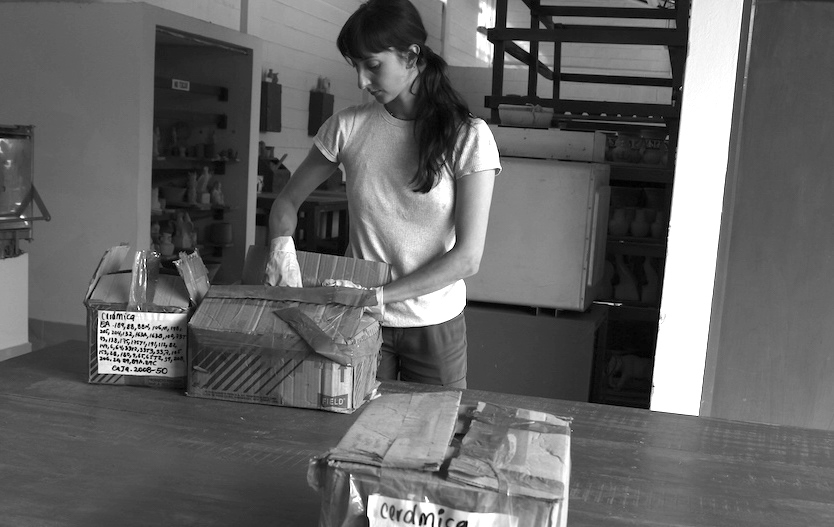
“I think the advantage of being on social media is that we are forming a connection and increasing interest in areas of art and archaeology in which people may not have been familiar before,” Menéndez Pereda added. “For others, it is just a platform to service their own research. Both of these purposes have created great value,” she concluded.
Deglin and Menéndez Pereda are also co-organizers of the Andean Working Group, housed in the Andean Laboratory, and are active in the Indigenous Material and Visual Culture Working Group. To support our research and education in archaeology and conservation, or for more information, please contact Michelle Jacobson at mjacobson@ioa.ucla.edu.
Sample images/posts
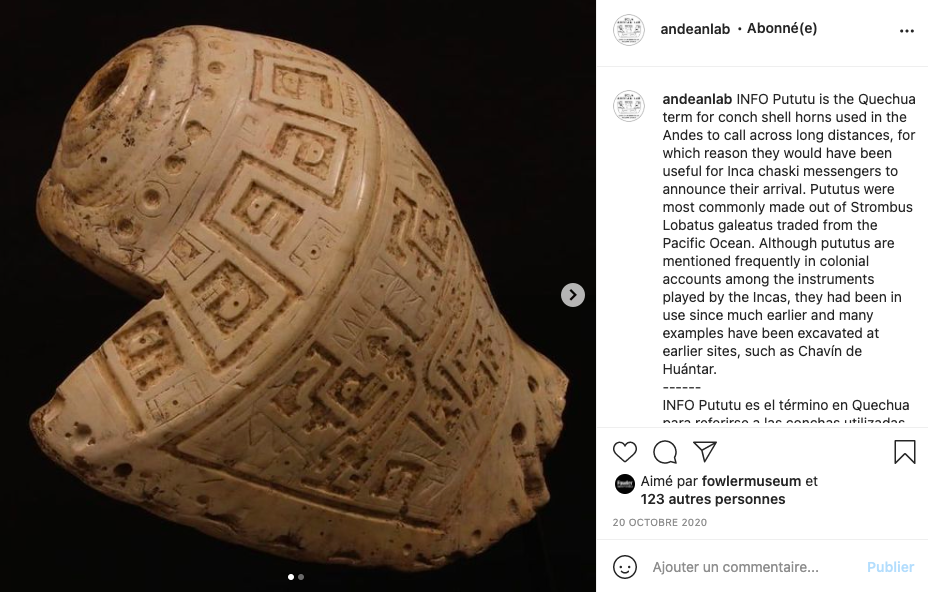
INFO / Pututu is the Quechua term for conch shell horns used in the Andes to call across long distances, for which reason they would have been useful for Inca chaski messengers to announce their arrival. Pututus were most commonly made out of Strombus Lobatus galeatus traded from the Pacific Ocean. Although pututus are mentioned frequently in colonial accounts among the instruments played by the Incas, they had been in use since much earlier and many examples have been excavated at earlier sites, such as Chavín de Huántar.
------
INFO / Pututu es el término en Quechua para referirse a las conchas utilizadas en los Andes para comunicarse a larga distancia, razón por la que habrían sido de gran utilidad para los mensajeros Inca chaskis. Los pututu eran fabricados con el molúsculo Strombus Lobatus galeatus, el cual era importado desde el Oceáno Pacífico. Aunque menciones a los pututu son abundantes en crónicas coloniales sobre instrumentos musicales Inca, los pututu han sido utilizados desde mucho antes. De hecho, un gran número de pututus han sido encontrados en Chavín de Huántar.
Read more: Kolar, Miriam A. 2018. “Archaeoacoustics: Re-Sounding Material Culture.” Acoustics Today; Stevenson, Robert. 1968. Music in Aztec and Inca Territory. University of California Press.
Image: 3,000-year-old pututu from Chavin. Photo by José Luis Cruzado via Chavín de Huántar Archaeological Acoustics Project website; Guaman Poma de Ayala, Nuevo Corónica y Buen Gobierno, 1615, Fol. 350 [352].
————————
#andes #andino #precolumbian #precolombino #indigenous #peru #peruantiguo #ancientperu #latinamerica #southamerica #music #ethnomusicology #instruments #musicology #inca #pututu #guamanpoma #conchshell #musica #instrumentos #chaski #mensajero #chavin

INFO / The chevron is a motif emblematic of Wari ceramics, which is found throughout the Wari empire. It most likely originated in Huarpa ceramics, and was later adapted by the Nasca through the Wari. Read more: Dorothy Menzel, “Style and Time in the Middle Horizon,” Ñawpa Pacha 2 (1964): 1–105.⠀
———————⠀
INFO / El cheurón es un diseño emblemático de los Wari, incluyendo su cerámica. Lo más probable es que fuera desarrollado en la cerámica Huarpa y tan sólo adoptado por los Nazca a través de los Wari. Read more: Dorothy Menzel, “Style and Time in the Middle Horizon,” Ñawpa Pacha 2 (1964): 1–105.⠀
———————⠀
Image: Wari bottle, @metmuseum. ⠀
#andes #andino #arteandino #andeanart #precolumbian #precolombino #indigenous #arteindigena #art #arthistory #archaeology #arqueologia #peru #peruantiguo #ancientperu #latinamerica #abyayala #southamerica #ceramic #ceramica #pottery #alfareria
Published on April 21, 2021.


